Browse using the new Vinous website now. Launch →
Printed by, and for the sole use of . All rights reserved © 2015 Vinous Media
Le Bistro de L’Hôtel de Beaune
3 Rue Samuel Legay
21200 Beaune
France
+33 3 80 25 94 10
BY NEAL MARTIN | APRIL 19, 2019
The Food
Carpaccio of langoustine tails with pancetta
L’oeuf cocotte façon d’Alba with white truffles
Sea bass “Hong Kong style”
Tajarin with white truffles
Poulet de Bresse “Chez Mieral”
Assorted Burgundy cheeses
Citrus fruits
The Wines
| 2006 Roederer Cristal | 96 |
| 2014 Domaine François Raveneau Chablis Butteaux 1er Cru | 94 |
| 2000 Domaine Drouhin Beaune Clos des Mouches Blanc l’Ouvrée des Dames 1er Cru | 94 |
| 1993 Domaine des Comtes-Lafon Meursault Les Perrières 1er Cru | 92 |
| 1972 Domaine Michel Lafarge Volnay Clos des Chênes 1er Cru | 94 |
| 1958 Château Grillet | 88 |
| 1958 Domaine de la Romanée-Conti Grands Echézeaux Grand Cru | ? |
| 1957 Domaine Georges Roumier Musigny Grand Cru | 95 |
| 1958 Domaine de la Romanée-Conti Romanée-Conti Grand Cru | 97 |
| 1958 Giovanni Gaja Barbaresco | ? |
| 1958 Cantina Mascarello Barolo Cannubi | 97 |
| 1958 Giacomo Conterno Barolo Monfortino | 92? |
| 1958 Biondi Santi Tenuta Il Greppo Brunello di Montalcino Riserva | 92 |
| 1958 Wynns Coonawarra Cabernet | 85 |
| 1958 Beaulieu Vineyard Cabernet Sauvignon Georges de Latour Private Reserve | 94 |
| 1958 Inglenook Classic Cabernet Sauvignon | 98 |
| 1958 Haut-Brion | 87 |
| 1958 Château Margaux | 88 |
| 1958 Certan de May | 92 |
| 1958 d'Yquem | 94 |
| 1958 Sandeman Vintage Port | 93 |
Nineteen fifty-eight seems a long time ago. The world was a different place. For a start, color had not been invented. Eisenhower was the sitting US president, and Howard MacMillan was prime minister in the UK. The space race kicked off between the superpowers, Russia taking an early lead against the US. A plane carrying the Manchester United football team, the “Busby Babes,” crashed at Munich airport, killing eight players. Jack Kilby invented the microchip. Elvis was drafted into the army but rock ‘n’ roll dominated the jukebox: Jerry Lee Lewis, the Everly Brothers and Buddy Holly. Cinemas reeked of Brylcreem as audiences flocked to see South Pacific and Cat on a Hot Tin Roof. The year is notable for significant births, producing not only the Jackson/Prince/Madonna triumvirate but also a future generation of Burgundy winemakers whose shared year of birth inspired the extraordinary dinner I am about to recount.

Sea bass with an East Asian twist.
One of my favorite places to eat during my Burgundy barrel tastings is Le Bistro de l’Hôtel, located in central Beaune overlooking Place Carnot. Established in 2007 by Stockholm-born Johan Bjorkland, it is upmarket yet unpretentious. A heavy velvet curtain draped across the front entrance keeps the autumn chill at bay, and the inside feels cozy and intimate. The walls are tastefully decorated with black-and-white photographs of legendary Burgundy vignerons, though my favorite photo is upstairs. It appears to be just another impromptu gathering of people, but look closely and you will find a young-looking Stephen Tanzer of this parish and one Robert Parker. I traditionally book a table on my final night of barrel tastings with my Burgundy assistant and order the restaurant’s signature dish, the poularde de Bresse with a bowl of creamy mash that Joel Robuchon would be proud of. Expensive, but worth every euro; you have to treat yourself sometimes.
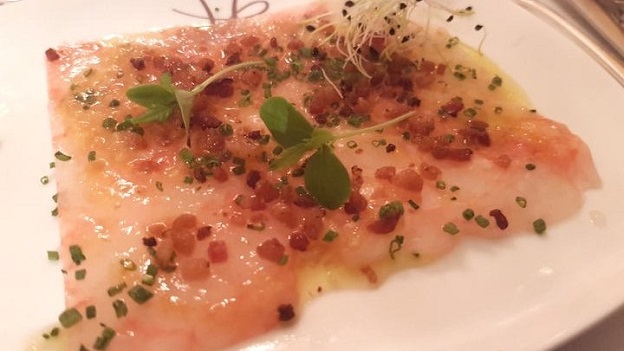
This carpaccio of langoustine was exceptional.
This particular dinner took place midway through last year’s tour of the Côte d'Or. Our host, a munificent friend from the US, was celebrating his 60th birthday and earlier that year had discovered that his favorite winemakers shared his year of birth. That was good enough reason to organize a 1958-themed dinner with friends and winemakers in the private room on the upper floor of Le Bistro de l'Hôtel. I cannot recall a smorgasbord of wine that delivered such abundant drinking pleasure and food for thought as this one did. Rarely do I find myself imbibing from one wine region to another while tethered to a single vintage. And not a famous recent vintage, but rather a somewhat forgotten growing season of yesteryear. This only heightened the intrigue as we navigated uncharted vinous waters. The blend of friends and off-duty winemakers, the cross-table banter and laughter, not to mention the hilarious and chaotic postprandial photo shoot, made this my favorite dinner of 2018.
The menu was specially prepared in advance. I won’t dwell too much on describing the food because this Vinous Table focuses more on the wine. But every dish was outstanding, the courses fresh and with a lightness of touch that meant nobody left feeling bloated. After an amuse-bouche of chestnut mousse, the carpaccio of langoustine tails with pancetta leapt off the plate, the langoustine perfectly moist and delicately seasoned.

It’s always a treat to eat white truffles, although this heathen has a penchant for its black cousin.
Given the time of year, two or three dishes included generous shavings of white truffles. While I appreciate this delicacy, it rarely excites me and, sacrilegiously, I prefer its cheaper black counterpart. Here, the white truffles were served with tajarin, the Piedmontese equivalent of taglierini. Simple, but frankly, any additional ingredients would have been otiose.
Of course, the menu had to include poulet de Bresse – simply the finest poultry on the planet. It doesn’t require any dissection or analysis; it’s just the most delicious chicken you can eat.
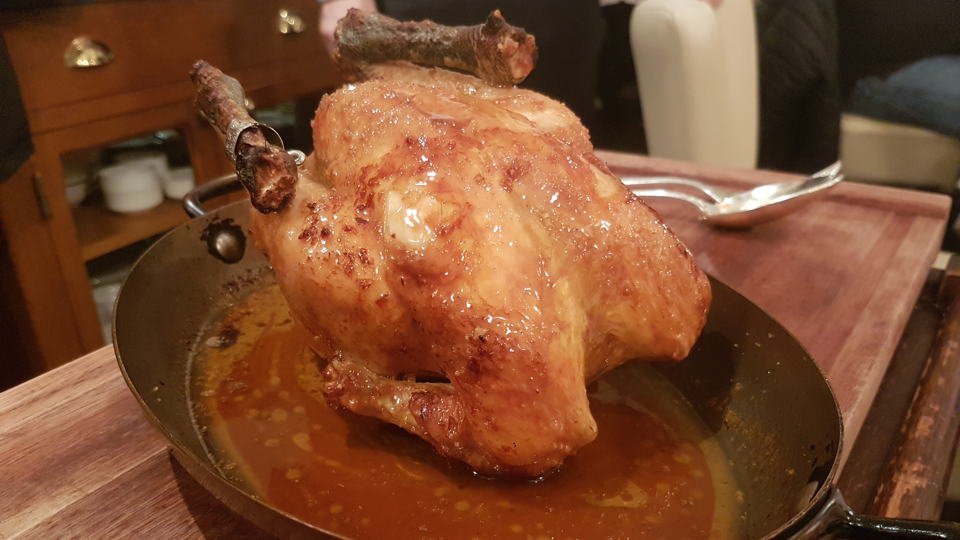
The poulet de Bresse I shared last November with my assistant, having completed four weeks of visits.
Now let us move on to the vinous fare, because there’s a lot to get through. It was an eclectic group of wines that focused mostly, though not exclusively, upon 1958. Delving into a less-reputed vintage is sometimes preferable to exploring an iconic one. For a start, your expectations are lower and, as the expression goes, a pessimist is never disappointed. Secondly, as anyone with experience of mature bottles will tell you, off-vintages tend to be written off when released, but reveal hidden virtues with age. They might not make your end-of-year lists, yet great growers and/or great vineyards have a proclivity to reward those with the wisdom to afford them time. Thirdly, unfashionable and less-reputed vintages tend to be less traded or transported, so provenance is often better (not that that was relevant here, since some bottles came directly from winemakers' cellars). Not all of the wines on this evening scaled dizzying heights, yet their contrasting fortunes were endlessly fascinating and kept your palate guessing. That is often more enjoyable than an uninterrupted series of amazing wines that make it easy to become blasé.
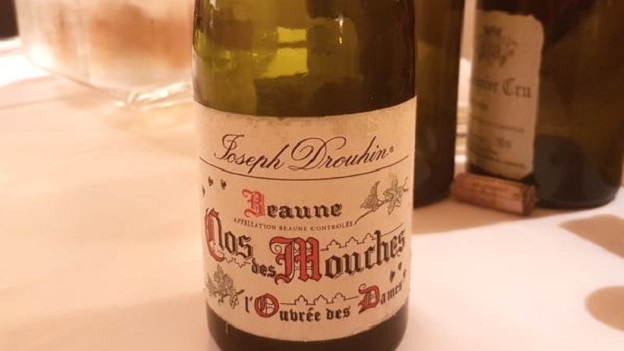
The rarely seen special cuvée from Drouhin’s Clos des Mouche, l’Ouvrée des Dames.
We commenced in appropriate fashion with the 2006 Cristal. The bouquet is drop-dead gorgeous, lively and broad, and beautifully defined as always, offering scents of citrus fruit, toasted walnuts and a hint of brioche. The exquisitely balanced palate displays spine-tingling mineralité and real tension and grace. The long, quite deep finish makes me wonder whether this 2006 will meliorate with further bottle age. Should I care, when it is so delicious now? Just superb.
Three whites followed.
The 2014 Chablis Butteaux 1er Cru from Domaine François Raveneau is drinking beautifully, even though I am fully aware of committing infanticide. It is one of my favorite vineyards – and in my view, an underrated one – from a benchmark Chablis growing season. A stunning, razor-sharp bouquet offers limestone and petrichor aromas, and hints of walnut and shucked oyster shells develop with aeration. That fresh marine influence translates into a palate that displays exquisite balance and just a hint of toffee apple, closing in slightly toward the finish. There is so much tension and grace here. Brilliant. It was partnered with a rare and fascinating wine bought by one of the winemaker guests, Véronique Drouhin. Stephen Tanzer recently published a fascinating and detailed report on her family's Clos des Mouches Blanc, but there was no mention of a special cuvée. I myself was oblivious to its existence until the bottle was revealed. If you search the Internet for the Beaune Clos des Mouches Blanc l’Ouvrée des Dames, you will find explanations that are not quite correct, and so I asked Véronique Drouhin to explain its fascinating origin herself. She told me: "In 2000 we invited the wives of the three-Michelin-starred chefs from France to Drouhin. Just the wives, not their husbands. Seventeen came. Along with my mother, Laurence Jobard, we picked one ouvrée (equivalent to 428 square meters or the amount a person could work in a day) of Chardonnay in the Clos des Mouches. The grapes were pressed on the old wooden press built in 1570, and we produced three barrels. After it was bottled, we gave most of the wine to the ladies but kept a couple of bottles in Beaune. I personally adore the wine. We don’t have any 1958s in the cellar, so I thought this would be something special. It was only made in 2000 and 2005."
The 2000 Beaune Clos des Mouches Blanc l’Ouvrée des Dames 1er Cru is refulgent in color, more youthful than one would suspect. It has wonderful intensity on the nose of struck flint, brioche, pine nuts, almond flakes and hints of coconut, conveying real energy and vigor. The palate is vibrant on the entry with a killer line of acidity, and saline in the mouth, offering Japanese yellow plum, praline and tangerine towards the harmonious finish. I absolutely loved this wine before I knew anything about it. Dominique Lafon offered the third white Burgundy. The 1993 Meursault Les Perrières 1er Cru has a generous hazelnut, brioche and adhesive-tinged bouquet that feels quite rich and powerful, not a common feature of the 1993 whites. The palate is well balanced with a faint viscosity. Notes of hazelnut, fennel and smoke lead to a surprisingly deep and voluminous finish, though perhaps it does not quite have the grace of Lafon's other wines from this period. Still, it has aged extremely well and should be consumed in the near future.
The last bottle of white came not from Burgundy but from the Rhône. I have encountered very few ancient bottles of Château Grillet. The 1958 Château Grillet came from the long period between 1825 and 2011 when the Neyret-Gachet family owned this famous property, before it was sold to François Pinault. The wine has a burnished straw color. The nose has aged well enough and presents dried honey, pond water, gingerbread and smoked walnuts; it is a little smudged in style and oddly reminiscent of a mature Barsac. The palate is quite rich and honeyed, offering bitter lemon and marmalade notes and good weight in the mouth, although the finish feels dried out. Enjoyable but not profound.

Probably the only time – and certainly the last time – that these two bottles were ever poured in tandem.
We then moved on to the flight of Burgundy reds – and what a treat was in store! We eased in with Frédéric Lafarge’s offering. It was actually the second time that I have encountered the 1972 Volnay Clos des Chênes 1er Cru from Domaine Michel Lafarge. Lafarge told me it was a late harvest that began on October 11 and that it was completely de-stemmed. Deep garnet in color, the wine has a satisfying bouquet of plump red cherries and hints of nougat, slightly ferrous in style and displaying wonderful definition. Tobacco scents begin to develop with time in the glass. The palate is medium-bodied with a tang of sour cherry on the entry, and firm in structure, not unlike a Pommard (echoing a remark I made apropos of the previous bottle.) Again, it reveals a ferrous tincture that becomes more prominent with time, but it is certainly not frail and exerts superb grip on the earthy finish. Magnificent. There were two Burgundy wines from the 1958 vintage. That appalling growing season saw rain from start to finish, and the berries were bloated and riddled with rot by harvest time. The 1958 Grands Echézeaux from Domaine de la Romanée-Conti was a bit tired on the nose and too oxidized for my liking. The palate was better, sporting a sweet core of mulberry fruit laced with espresso and blood orange, though slightly metallic, with what felt like a very chaptalized finish. I am sure there are better bottles out there.
That was disappointing. However, the next pair more than compensated. They were two iconic wines rarely seen together, let alone at six decades old. The 1957 Musigny Grand Cru came from Christophe Roumier's grandfather's cellar and had been re-corked in 1983. It has a pale ruby core with a tawny rim. The mesmerizing bouquet features scents of tart red fruit, Moroccan spice, orange peel and a faint touch of wild mint. It comes across bashful at first but blossoms in the glass, ending up quite crystalline. The exquisitely balanced palate is framed by filigreed tannins. It is not profound in terms of complexity, yet it is as fresh as a daisy, elegant and refined, offering life-affirming transparency and revealing hints of tobacco on the saline aftertaste. Absolutely wonderful. An equally astonishing bottle stood alongside. The 1958 Romanée-Conti is a vintage that I have tasted once before, and this bottle came from the same source: Alejandro Zaffaroni's cellar (name-checked in Michael Broadbent’s Vintage Wine tome), which was sold through Christie’s a few years ago. There is no question that this was the better of the two bottles I have tasted. It has an iridescent hue with some bricking on the rim. The bouquet is vibrant and fresh, featuring red cherries, wild strawberry, warm bricks and hints of roasted chestnut, and a less conspicuous undergrowth element compared to the bottle I encountered in October 2015. Ineffably elegant and utterly refined, this delivers vivid red fruit, soul-affirming mineralité and precise, filigreed tannins. It fans out discreetly on the finish but never overreaches. While not the most profound Romanée-Conti that I have tasted, there is no doubt that it transcends its tricky growing season and at 60 years of age is a light undimmed.
We then headed off to Italy. Now, my experience of mature Italian wine is a fraction of my colleagues’ and I freely admit lacking context; I just judged the bottles as I found them. The 1958 vintage is a legendary one that produced "powerful, virile Barolos," according to the Vinous vintage summary, and that was confirmed by one or two beauties that blew my mind.
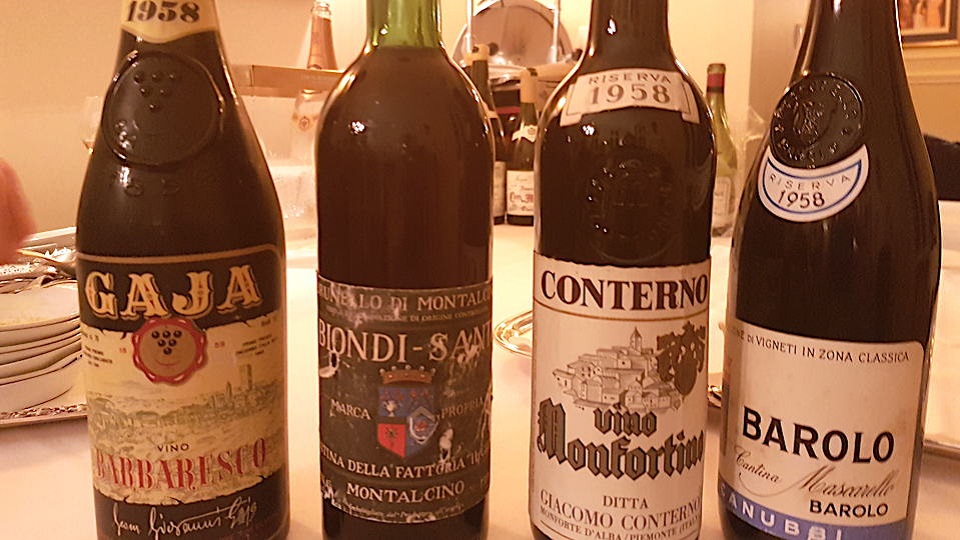
The 1958 is a legendary vintage in northern Italy, and a couple of bottles here attested to the quality and longevity of the wines.
Our Italian excursion did not get off to a great start. The 1958 Barbaresco was made by Angelo's father Giovanni Gaja. Examining the bottle, I could not find any reference to "Infernot," mentioned in the note in the Vinous database, so I assume it was a regular bottling. Antonio told me that "Infernot" was in fact the last cask to be bottled in the old days, so this bottle essentially constituted everything else. It is probably a moot point because I found it far too volatile on the nose, displaying a strong scent of Benedictine. The palate struggled to shake off volatility, and though there is an attractive wine in there somewhere, in the end it expired rapidly in the glass. That was soon forgotten thanks to the extraordinary next bottle. The 1958 Barolo Cannubi from Cantina Mascarello is among the greatest Piedmont bottles I have ever tasted. As Antonio Galloni mentioned in his Vinous note on the 1955, the label is spelled "Canubbi." The heavenly bouquet of maraschino cherries, peony, peppermint and crushed strawberry envelops the senses. The palate is built around a superb frame of tannins, the layers of dark berry fruit, black olive and blueberry leading to a powerful, multidimensional but utterly refined finish that takes your breath away. This just felt so... alive. I understand why wine lovers are besotted by old Barolo! The 1958 Barolo Riserva Monfortino from Giacomo Conterno has a rich bouquet of smudged red and blue fruit, leather and roasted chestnut. It is mightily impressive, though it does not achieve the same heights as Mascarello's 1958, and this bottle developed an odd Turkish delight scent with aeration. The palate is certainly volatile and shows advanced maturity, which is unsurprising given its age, yet there is admirable grip and a sweet, slightly candied-prune-like finish that I find appealing, even if it lacks some precision. The fourth Italian saw us leaving Piedmont for Tuscany. The 1958 Brunello di Montalcino Riserva from Biondi Santi has a Burgundian nose of tart cherries, chestnut, mint and orange zest, quite vigorous given its age, and fresh but not as powerful as the Barolo from Mascarello. The slightly ferrous palate offers kirsch and candied orange peel on the entry, commendable acidity and a curiously Saint-Émilion–inspired finish that is harmonious and long. It does not match the spellbinding 1955 that I drank over a decade ago, but it was still delicious and could give a few more years of pleasure, subject to provenance.
Off to the New World. We commenced in Coonawarra, the first region I ever visited in Australia. The 1958 Coonawarra Cabernet from Wynn's has a perfumed bouquet of mint and hickory, a little ragged with age but holding up (just). The palate is medium-bodied with dry tannins, a little hollow compared to some of its peers, and attenuates rapidly on the finish. This should be drunk soon.
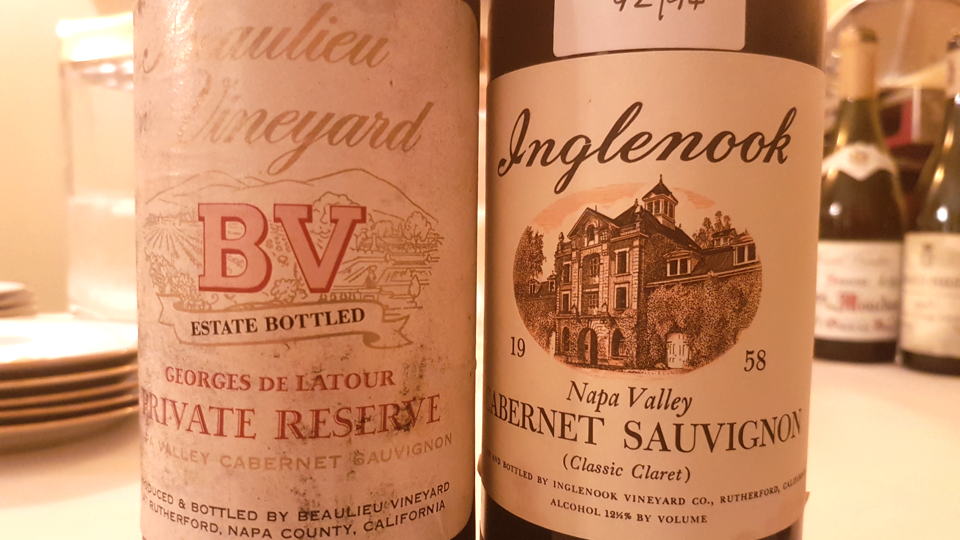
Two iconic bottles of ancient California wine from Beaulieu Vineyards and Inglenook.
The Californian pair easily matched the Old World legends. The 1958 Cabernet Sauvignon Georges de Latour Private Reserve from Beaulieu Vineyard has aged extremely well. It is quite deep in color, and the bouquet unfurls enticingly with gorgeous scents of blackberry, white pepper, camphor and just a hint of hickory, all beautifully defined and somehow warm and inviting. The palate is medium-bodied and surprisingly Médoc-like in structure, displaying potent menthol notes that do not overwhelm the core of red fruit, which segues into a tobacco and smoke finish. It is superb in a "correct" kind of way. The heavenly 1958 Classic Cabernet Sauvignon from Inglenook came from Graham Lyons’ cellar (meaning it had virtually perfect provenance). Still youthful in color, it has a show-stopping nose of ripe red fruit, aniseed, blueberry pie and pain d’épices, all delivered with bewitching complexity and harmony. The palate is as complex and refined as any you will find in Bordeaux. Perfectly balanced with fine tannins, it is blessed with a sensual, velvety-smooth texture and layers of pure red fruit tinged with allspice. This is so crystalline and poised that you have to bow down in its presence. A testament to the brilliance of legendary winemaker John Daniel Jr.
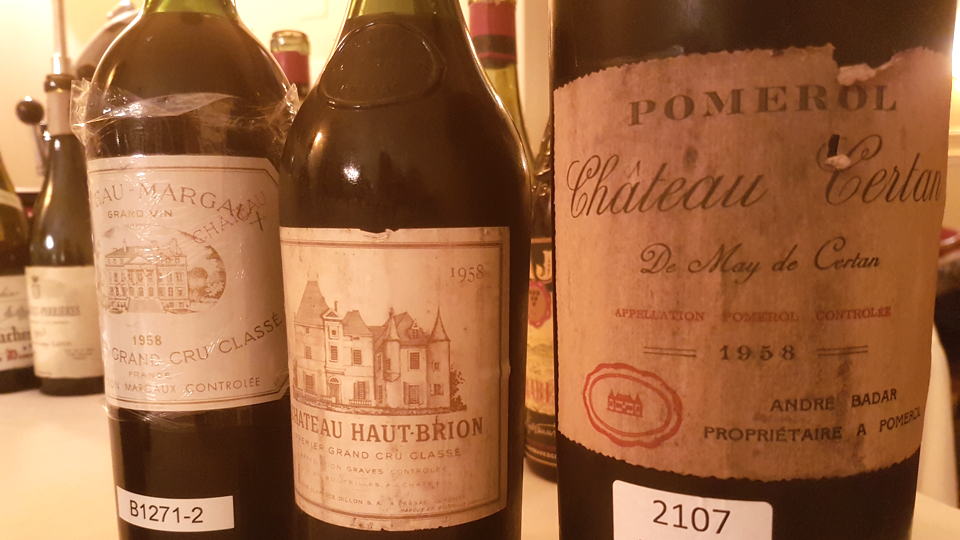
The Pomerol notwithstanding, the Bordeaux flight did not match the excitement of others that evening.
The two First Growths that followed could not match the Inglenook. In fact, they were the lull in an otherwise extraordinary evening, principally because the Bordeaux growing season was spoiled by 126mm of rain in August. The 1958 Haut-Brion, picked October 8–16, is one of the last vintages made by Georges Delmas, grandfather of present winemaker Jean-Philippe. It shows moderate bricking. Sandalwood, incense, roasted chestnut and autumn bonfire on the nose indicate maturity, and the lack of intensity reflects a difficult growing season. With time, there are light aniseed aromas, but the aromatics never achieve liftoff. The palate is medium-bodied with dry, slightly dusty tannins, and strong tobacco notes rather overwhelm the vestiges of fruit. This is a fading Graves that should be consumed in the near future. The 1958 Château Margaux has a fragrant bouquet of brown spices, leather and game; a subtle cocoa scent emerges with time. Like the 1958 Haut-Brion served alongside, the tannins initially seem dry and hard, although I find more pedigree on the finish compared to the aforementioned Graves, and there is a leathery aftertaste. This does fade in the glass, so leave the decanter in the cupboard if you find a bottle. The best wine of the evening came from Pomerol. The magnum of 1958 Certan de May was made just a couple of years after the passing of proprietor André Badard, whereupon his wife and daughter took over the running of this Pomerol estate. I admire the purity on the nose of black cherries and black truffle, which reveals a touch of VA, though it’s nothing to get worried about. The palate is well defined with good intensity. Kirsch and orange zest intermix with molasses and brown spices, all kept in check by a solid tannic frame. There is a lovely dab of fig on the finish, completing a Pomerol that can hold its head up high.
We finished with a dessert wine and a fortified wine. The 1958 d’Yquem is an off-vintage that I have not encountered before. Fifty millimeters of rain in September was the catalyst for botrytis, and the harvest was picked in four tries between October 6 and 24. Lucid amber in color, the wine has a vibrant bouquet of tangerine, melted candle wax and a light glue-like aroma. It feels well defined and very focused. The palate is medium-bodied with a viscous opening, and much more powerful than expected, offering blood orange, crème brûlée and honeyed notes. Perhaps it has its wings clipped on the finish, but otherwise this is a fine showing in a tricky Sauternes vintage. Well-kept bottles could probably give another decade's worth of drinking pleasure. Finally, there was the 1958 Sandeman’s Vintage Port. The attractive nose of blueberries and kirsch reveals hints of singed leather and fig with time. The palate has a satisfying richness and a keen thread of acidity that maintains freshness. Well-balanced, not complex, but delivering layers of gorgeous glossy red fruit mixed with marmalade and spices on the finish, this is really a rather glorious Vintage Port.
At the end of the evening came the obligatory photo call. It is rare to find such growers assembled together, so the occasion had to be recorded. It had been a very special night with exemplary dishes, exceptional wines and above all, impeccable company. For one evening, we traveled back six decades and discovered that 1958 bestowed some remarkable wines that were probably soon forgotten after 1959 and 1961 - but not tonight.
(My sincere thanks to Mr. P and everyone who contributed bottles on this amazing evening.)
Show all the wines (sorted by score)
- Beaulieu Vineyard
- Biondi Santi - Tenuta Il Greppo
- Cantina Mascarello
- Certan de May
- Château-Grillet
- Château Margaux
- Domaine de la Romanée-Conti
- Domaine des Comtes Lafon
- Domaine François Raveneau
- Domaine Georges Roumier
- Domaine Michel Lafarge
- Gaja
- Giacomo Conterno
- Haut-Brion
- Inglenook
- Joseph Drouhin
- Roederer
- Sandeman
- Wynns Coonawarra Estate
- Yquem
